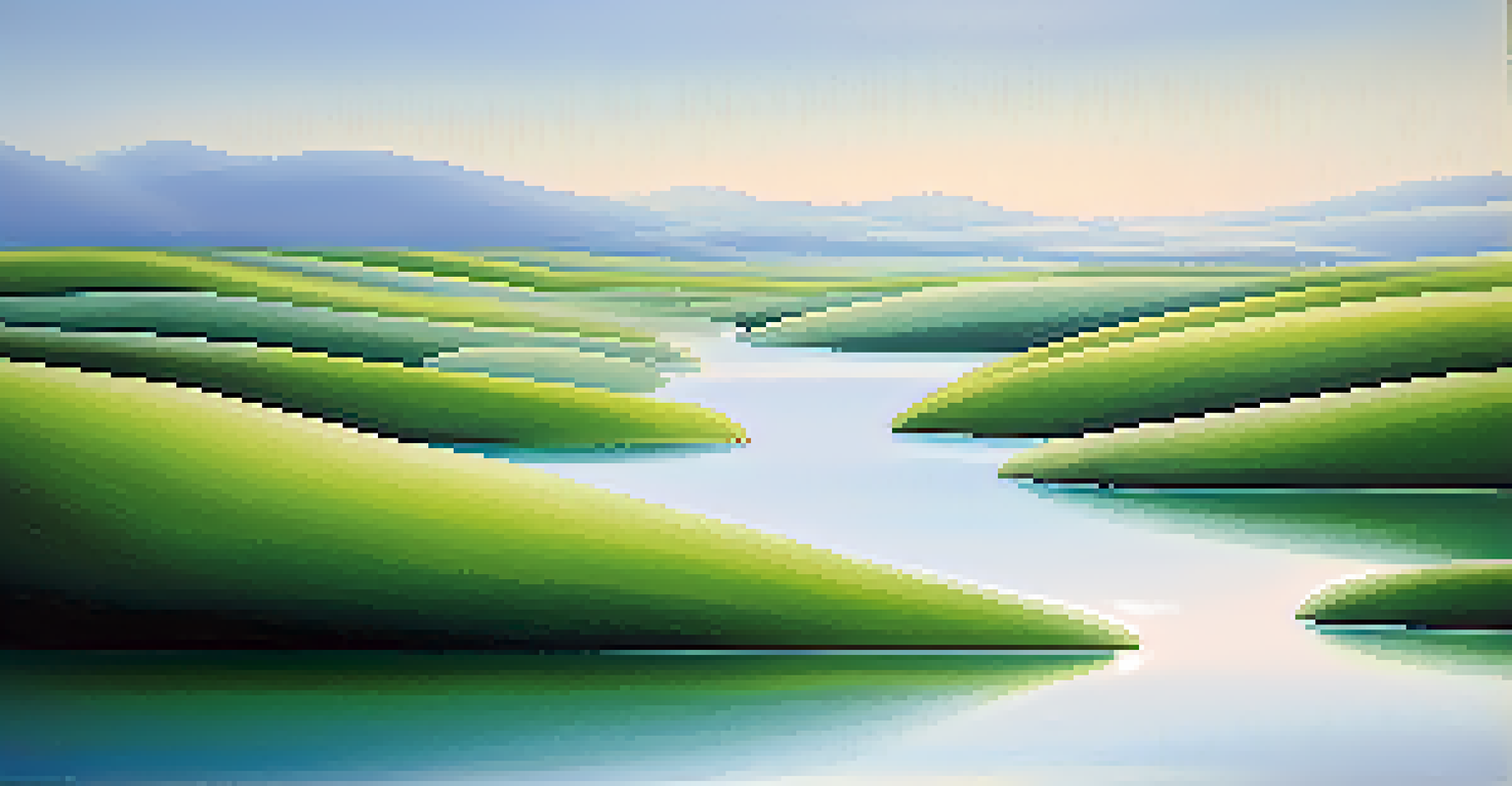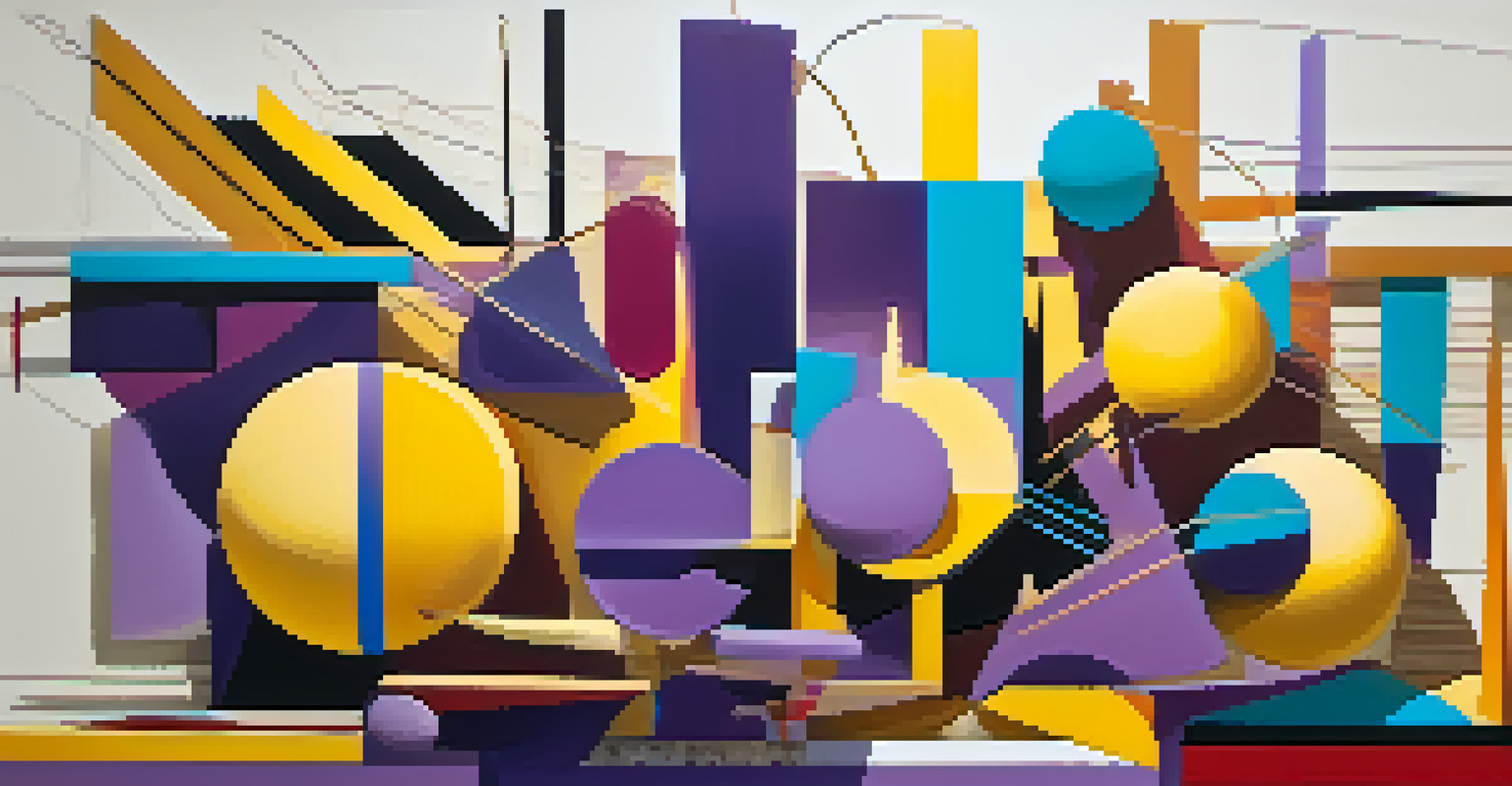The Role of Color in Abstract Painting Throughout History

The Beginnings of Color in Abstract Art: A Historical Overview
Abstract painting has its roots in the early 20th century, breaking away from traditional representation. Artists began exploring color not just as a visual element but as a means of expression. This shift marked a significant departure from the real-world depiction, allowing color to take center stage in conveying emotions and ideas.
Color is the keyboard, the eyes are the harmonies, the soul is the piano with many strings.
Early pioneers like Wassily Kandinsky believed that colors could evoke specific feelings and experiences. He famously linked colors to musical notes, suggesting that just as music stirs emotions, so too could color in painting. This innovative approach ignited a movement where artists began to prioritize their emotional responses over realistic portrayals.
As abstract art evolved, the use of color became a vital part of the artistic language. Each hue, shade, and tone held meaning and could influence how a viewer interpreted a piece, making color a powerful tool for communication in the abstract realm.
Key Movements: Color Exploration in Abstract Art
Throughout history, various movements have emerged that highlight the role of color in abstract art. For instance, the Color Field movement in the 1950s and 60s focused on large expanses of color to evoke emotional responses. Artists like Mark Rothko and Barnett Newman utilized color as the primary subject, inviting viewers to immerse themselves in the experience.

Another notable movement was the Abstract Expressionism of the mid-20th century, where artists like Jackson Pollock and Helen Frankenthaler experimented with spontaneous color application. Their techniques brought an organic and dynamic quality to their work, showcasing how color could be applied in innovative ways to express the artist's inner turmoil or joy.
Color as Emotional Expression
Abstract art uses color not just visually but as a profound means of conveying emotions and ideas.
These movements not only pushed the boundaries of what abstract art could be but also emphasized the importance of color in shaping the viewer's experience. The deliberate choices made by these artists reveal a deeper understanding of color as an essential element in conveying meaning.
Symbolism of Color in Abstract Painting
Color in abstract painting often carries symbolic meanings that vary across cultures and contexts. For example, red can symbolize passion or anger, while blue might evoke tranquility or sadness. Artists have harnessed these associations to deepen the impact of their work, creating layers of meaning that resonate with viewers on a personal level.
Colors are the smiles of nature.
Take, for instance, the work of Paul Klee, whose use of color was often whimsical yet profoundly symbolic. His paintings invite viewers to explore their interpretations, as the colors chosen can trigger different emotions based on individual experiences. This interplay between artist intent and viewer perception is a hallmark of abstract art's power.
The symbolism of color also evolves over time, reflecting societal changes and cultural shifts. As artists respond to the world around them, the meanings attached to colors can transform, making the study of color in abstract painting a dynamic and ever-evolving field.
The Psychological Impact of Color in Abstract Art
Color psychology plays a significant role in how we perceive abstract paintings. Different colors can evoke various emotional responses, influencing how we feel when we look at a piece of art. For instance, warm colors like red and orange can energize, while cool colors like blue and green may calm the viewer's mind.
Artists often consider these psychological effects when choosing their color palettes. For example, a predominance of warm colors in a painting may create an intense atmosphere, evoking feelings of excitement or discomfort. Conversely, a cooler palette can foster a sense of peace and introspection, drawing the viewer into a more meditative state.
Cultural Influences on Color Use
An artist's cultural background significantly shapes their color choices, impacting the meanings conveyed in their abstract works.
Understanding the psychological impact of color allows both artists and viewers to engage more deeply with abstract works. It serves as a reminder that colors are not just visual elements but powerful emotional triggers that shape our experiences and interpretations of art.
Technological Advances and Color in Abstract Painting
As technology has advanced, so too has the palette available to abstract artists. The invention of synthetic pigments and modern art supplies has expanded the range of colors artists can use, allowing for greater experimentation. This innovation has led to vibrant works that were previously impossible with traditional materials.
Digital art has also opened new avenues for color exploration in abstract painting. Artists can manipulate colors with precision, creating stunning effects that challenge our perceptions. The ability to instantly adjust hues, saturation, and brightness allows for a level of experimentation that can lead to unexpected and exciting results.
These technological advancements not only enhance the aesthetic aspects of abstract art but also encourage a new generation of artists to explore color in innovative ways. As the tools of creation evolve, so does the language of color, continually reshaping the landscape of abstract painting.
Cultural Influences on Color Choices in Abstract Art
Cultural backgrounds significantly influence how artists perceive and use color in their abstract works. Different cultures have unique associations with various colors, which can impact an artist's choices. For instance, in many Eastern cultures, red symbolizes good fortune, while in some Western contexts, it may represent danger or love.
Artists like Yayoi Kusama have drawn upon their cultural heritage to infuse their work with specific meanings associated with colors. Kusama's use of vibrant hues reflects her unique perspective, blending personal symbolism with broader cultural narratives. This fusion creates a rich tapestry of meaning that invites viewers to explore different interpretations based on their own cultural frameworks.
Future Trends in Color Exploration
The future of color in abstract painting will embrace new materials and techniques, reflecting societal values and encouraging innovative expressions.
As global interactions increase, artists often blend influences from multiple cultures, resulting in diverse color palettes. This cultural exchange enriches abstract art, making it a fascinating study of how color transcends boundaries and connects us all through shared experiences.
The Future of Color in Abstract Painting
Looking ahead, the future of color in abstract painting promises to be as vibrant and diverse as the artists who create it. With the continued development of new materials and techniques, artists can push their creative boundaries even further. This evolution will likely lead to unprecedented color combinations and innovative uses of space and form.
As societal values shift towards inclusivity and sustainability, artists may also begin to reflect these themes in their color choices. Eco-friendly materials and a focus on cultural representation could shape the future palettes of abstract art, making it a medium that not only expresses personal vision but also addresses broader societal concerns.

Ultimately, the role of color in abstract painting will continue to evolve, challenging artists and viewers alike to explore new meanings and experiences. The journey of color in art is an ever-changing narrative, one that reflects the complexities of human emotion and the world around us.